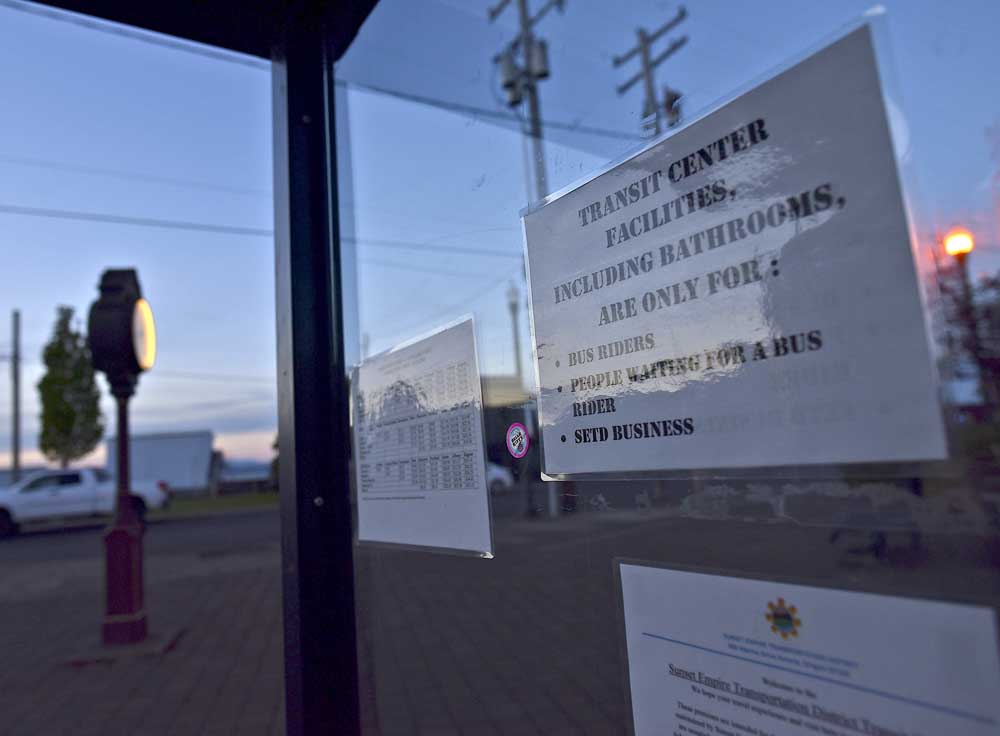Disturbance calls at Astoria transit center plummet
Published 8:00 pm Tuesday, May 8, 2018

- Signs posted at the transit center indicate rules to discourage loitering and other disruptive behavior.
A surge of behavioral and safety issues at the Sunset Empire Transit Center appears to have been halted. What that means for the neighborhood remains unclear.
Trending
Last year, Astoria police responded to 45 disturbance calls at the bus terminal, nearly six times the number reported in 2016. But so far this year, police have fielded just five calls.
The lower figure appears to be the result of a number of steps the transit district started taking last year to make the center safer.
“It’s worked out wonderfully so far,” said Jeff Hazen, the transit district’s executive director.
Trending
Business owners, police and local nonprofits have pointed to a small but growing segment of the city’s homeless population — typically younger people from out of town — as responsible for criminal activity and aggressive behavior.
The transit center is often their first stop, and while the center’s reputation as a hub for people without local shelter is dwindling, surrounding businesses continue to see disturbing activities.
“It just keeps changing, just new faces all the time,” said Tom Schmidt, owner of Phog Bounders Antique Mall across the street from the transit center. “As soon as you get control, a whole new group of them shows up. I find it very odd.”
People who work at or near the transit center started noticing new, more aggressive, homeless people in the area the past few years, with last year being a peak.
The transit center was often the site of criminal activity, including assault. In the bathrooms, sinks were being used as showers, clothes would be stuffed in toilets, used needles were found and lice infestations were common. Adults would gather in children’s play areas and blare music.
Adopted last May, an ordinance approved by the transit district addressed a wide range of behaviors — including body odor and the use of shopping carts — at the center and on buses. A private security company was hired to enforce the rules the first few weeks, and a guard still patrols on weekends. Bathroom doors have been locked more often.
“We don’t have the transient population hanging around us as much any more. They get it,” Hazen said. “They’re still around us, but they tend not to come over on the transit center property.”
Rather, many have either moved out to surrounding sidewalks or a small grassy patch on Ninth Street near the Astoria Riverwalk. Business owners still see signs of aggressive behavior, including one person who constantly knocks on drivers’ windows.
Schmidt said he has also heard complaints from customers.
“When somebody is getting out of their car and someone gets in their face, they may want to get back in their car or not even come back,” Schmidt said.
Business owners who try to speak with people causing the issues often have been met with more aggressiveness.
“There’s no being nice to them,” Schmidt said. “You know what you get back.”
Soon after the transit center’s ordinance was passed, Kent Birdeno, owner of Commercial Adjustment Co. across from the center on Marine Drive, complained of people who appeared to be homeless gathering behind the building and leaving trash. Since then, those sightings have become less frequent.
Construction efforts nearby may account for the reduction of debris, but Birdeno is cautiously optimistic.
“I just haven’t seen the trash down there in quite a while now,” he said. “Whether or not it will return, I’m not sure.”
Clatsop Community Action, a nonprofit that helps homeless people find resources such as food and housing, estimated last year that 682 people in the county are homeless. Though the county has the 19th largest total population in the state, it has fifth-largest homeless population.
The Astoria City Council voted in February to support more aggressive enforcement of low-level offenses, an attempt to target the segment of homeless people who violate laws. Property Watch, an Astoria police program allowing officers to supervise specific properties after hours on the owners’ behalf, has attracted more than 40 businesses — including Commercial Adjustment, Phog Bounders and the transit center.
As businesses and the city continue efforts to curb aggressive panhandling, people without shelter have been finding other places to live after being asked to leave by police or property owners.
Sgt. Andrew Randall said earlier this year that more homeless camps have been spotted in wooded areas that are harder to locate. They are also near residences, which has drawn complaints from homeowners.
“I feel bad for the people. I really don’t know what the answer is,” Birdeno said.
A new homeless shelter and re-entry program in a former Uniontown boarding house, which may hold up to 70 people, could open by July. In winter months, the Astoria Warming Center has a capacity of 30 people per night.
For the moment, though, property owners — in the transit center and elsewhere — remain unsure when or how the issues they’ve reported will be fixed.
“It’s a constant,” Schmidt said. “It’s always been a temporary fix.”









